Research Article - (2021) Volume 0, Issue 0
Phenological status of Anatidae in the lake of Ayata- El-Oued (Algeria)
L. Soumaya1, A. Baaloudj2*, H. rizi3, I.E. Saker1, I. Houhamdi2, S. Sihem1 and M. Houhamdi2Abstract
The ecological study of Anatidae carried out during an annual cycle (2019/2020) in the Lake of Ayata in the South-East of Algeria, constitutes a winter refuge for a great diversity of waterbirds. The specific richness and the evolution of the numbers of Anatidae were helpful to define the status and the phenology of eleven species, including 5 species wintering namely (Anas acuta, Anas clypeata, Aythya nyroca, Anas crecca crecca, Tadorna tadorna) and 3 sedentary nesting species (Anas platyrhynchos, Marmaronetta angustirostris, Tadorna ferruginea). The daily activity rhythm of all species is dominated by sleep, which accounts for more than half of the total time, (56.62%). The Lake of Ayata acts as a stopover site for migratory species during their trans-Saharan migrations.
Keywords
Anatidae, South-eastern Algeria, Specific wealth, Phenology, The Lake of Ayata, Diurnal behavior.
Introduction
Algeria has many little-known wetland complexes which are veritable sanctuaries for flora and fauna (Houhamdi, 1998). These wetlands are part of a vast Mediterranean eco-complex that was exploited by water birds communities structured in metapopulations (Seddik et al., 2012; Bouali et al., 2021). The Algerian climate is diverse (subtropical, Mediterranean, semi-arid and arid) (Samraoui and De Belair, 1998; Stevenson et al., 1988). It contains 2375 natural and 319 artificial wetlands, 50 are listed on the Ramsar list of international important wetlands (D.G.F., 2016). Saharan wetlands constitute essential ecosystems, hosting several species of sedentary, migratory and passage waterbirds (Bouzid, 2017). The biological diversity of wetlands located in arid zones (chotts, sebkhas, gueltas and oases) makes them important water reservoirs for local communities and which are home to several hundred thousand sedentary and migratory birds (DGF, 2001). The Lake of Ayata is one of the most important wetlands in the Oued Righn Valley, which represents a set of oases circumscribed between the wilayas of Biskra, El-Oued and Ouargla (Bouzegag et al., 2013) and it is located in the south-east of the region. Algeria constitutes a wintering and breeding ground for many water birds including the Pink Flamingo in Chott Merouane (Bensaci et al., 2013; Nouidjem, 2008). Studies on the wintering strategy of waterbirds, their spatial and temporal occupancy patterns and their diurnal behavior remain among the major concerns to determine the ecological role that a site can play. Thus, regular counts and monitoring have a great interest in understanding the structure and functioning of wetlands (Houhamdi and Samraoui, 2001, 2002, 2003, 2008; Bouali et al., 2021).
Our study carried out over a consecutive year (August 2019 to July 2020) and it is based on an inventory of all Anatidae that frequented in the Lake of Ayata in order to determine their phenological status (wintering, sedentary, summer or sporadic species) and to define their diurnal use of this wetland.
Materials and Methods
Study area
Lake of Ayata (33°29.867'N, 5°59.403'E) is the shallow body of water of forty hectares and is located near the town of Sidi-Amrane 5 km south of the city of Djamaa, it is one of the most important wetlands in the Oued Righn Valley (Fig. 1 and Fig. 2). It has an average depth of 80 cm and practically in water throughout the year. it is entirely surrounded by Phragmites australis and it also represents a favorable wintering place for many Anatidae (Northern shoveler, Pintail, Teal marbled, Teal…) and Ardeidae (Gray heron, Cattle egret, Little egret).
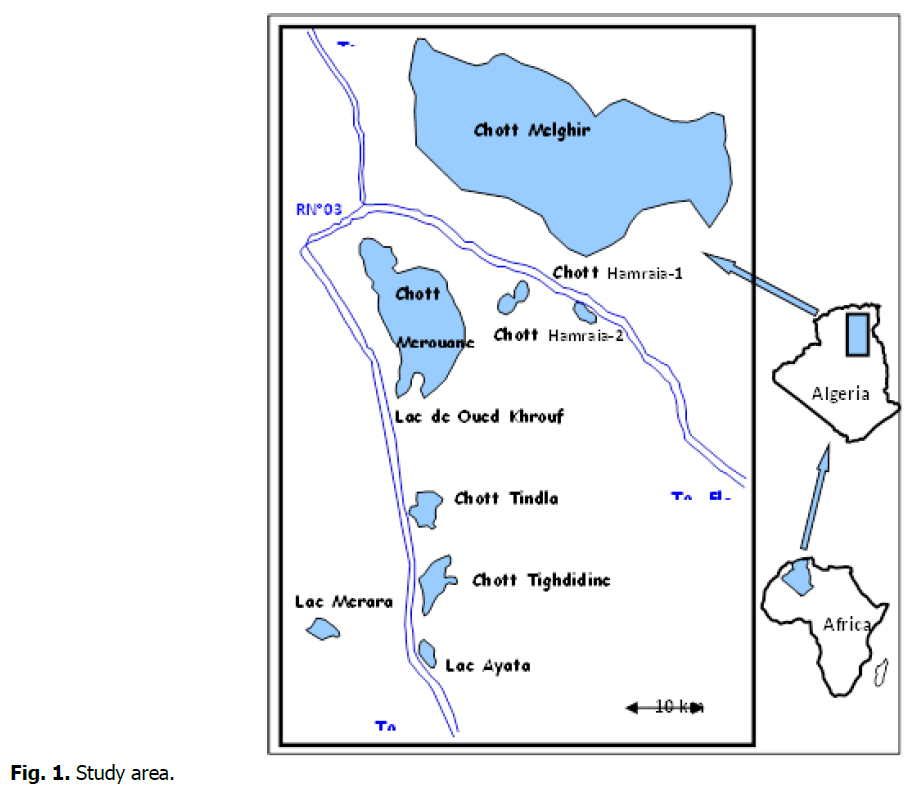
Fig 1. Study area.
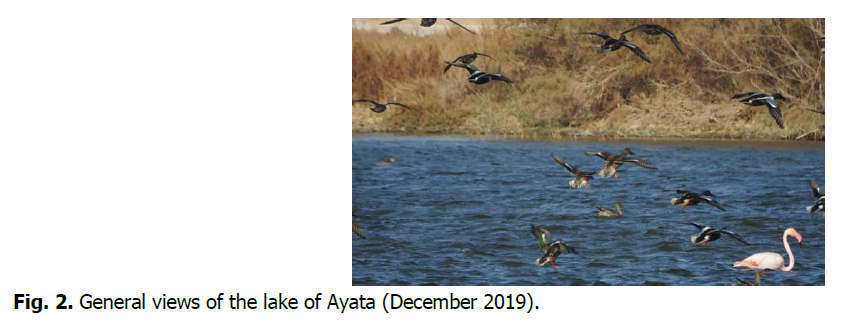
Fig 2. General views of the lake of Ayata (December 2019).
Sampling
The monitoring of the phenology and structure of the Anatidae population was carried out during an annual cycle at a bimonthly rate from August 2019 to July 2020 by telescope and a pair of binoculars. The counts were made by two methods; either by counting all the individuals when the group of water birds is close to the observation point and has less than 200 individuals (Lamotte and Bourlière, 1969; Blondel, 1975; Houhamdi, 2002); Or by visual estimation if the number is very high and the birds are at a significant distance (Aissaoui et al., 2011; Houhamdi and Samraoui, 2001; 2003; 2008). This second method has an estimated margin of error between 5 and 10% (Lamotte and Bourliere 1969) and it also depends on the experience of the observer and the quality of the used optical equipment (Legendre and Legendre, 1979; Tamisier and Dehorter, 1999). Concerning the study of the diurnal activity rhythms of Anatidae, we opted for the SCAN method that was done every hour, from 9 a.m. to 4 p.m. (Baldassare et al., 1988; Losito et al., 1989; Boulekhssaim et al., 2006; Tamisier and Dehorter, 1999). The measured activities are sleeping, feeding, swimming, grooming and flying. (Houhamdi and Samraoui, 2001; 2003; 2008; Metallaoui et al., 2009).
Results
The study revealed a specific richness of the Anatidae of this wetland that it is composed of 11 species, including 5 species wintering namely (Anas acuta, Anas clypeata, Aythya nyroca, Anas crecca crecca, Tadorna tadorna) (Table 1). The observed species represent different phonological statuses: the wintering species represented more than 46%, 27% of sedentary nesters and 27% of passing visitors (Fig. 3).
| Species | Aug | Sep | Oct | Nov | Dec | Jan | Feb | Mar | Apr | May | Jun | Jul |
|---|---|---|---|---|---|---|---|---|---|---|---|---|
| Anas strepera | + | + | ||||||||||
| Anas platyrhynchos | + | + | + | + | + | + | + | + | + | + | + | + |
| Anas acuta | + | + | + | + | ||||||||
| Anas clypeata | + | + | + | + | + | + | + | |||||
| Aythya ferina | + | + | ||||||||||
| Aythya nyroca | + | + | + | + | + | + | + | |||||
| Anas querquedula | + | + | ||||||||||
| Anas crecca crecca | + | + | + | + | + | |||||||
| Marmaronetta angustirostris | + | + | + | + | + | + | + | + | + | + | + | |
| Tadorna ferruginea | + | + | + | + | + | + | + | |||||
| Tadorna tadorna | + | + |
Table 1. Phenological status of waterbirds observed at the Lake of Ayata.
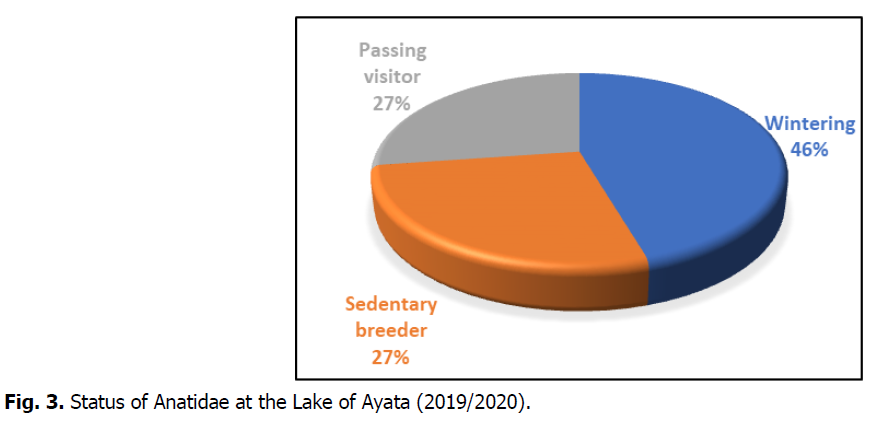
Fig 3. Status of Anatidae at the Lake of Ayata (2019/2020).
The monitoring of the rhythm of the daytime activities of Anatidae is dominated by sleep with an average percentage of (56.63%). This activity is followed by swimming (20.88%), then respectively by maintaining the plumage and feeding (10.5%; 7.38%) and finally flying with 4.63% (Fig. 4).
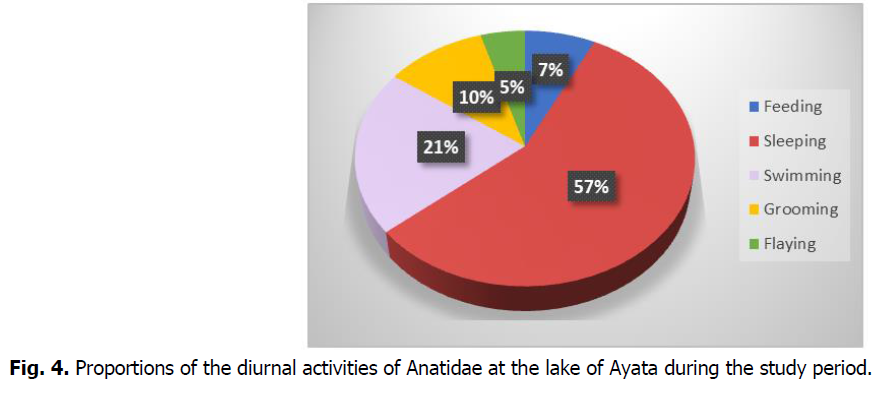
Fig 4. Proportions of the diurnal activities of Anatidae at the lake of Ayata during the study period.
The variation in the total abundance of Anatidae that frequented at the Lake of Ayata shows us that this wetland is never empty but always occupied by a given species of waterbird (Fig. 5a). The minimum observed is 8 individuals during the first half of July 2020 and a maximum of 537 individuals, recorded during the first half of November 2019. But in general, we can say that the Lake of Ayata is richer in water birds during the winter period.
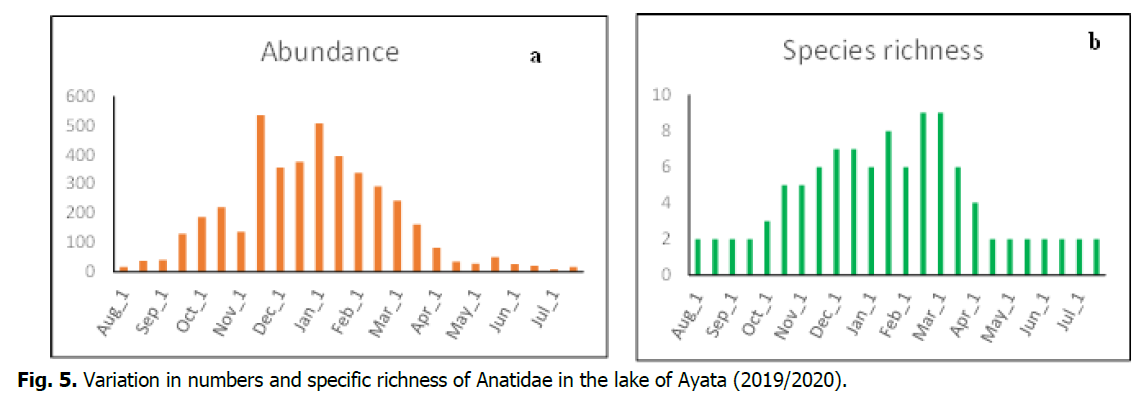
Fig 5. Variation in numbers and specific richness of Anatidae in the lake of Ayata (2019/2020).
The graph of specific richness exhibits roughly the same shape as the abundances (Fig. 5b). Indeed, the winter period is characterized by a very important specific richness. The maximum value is recorded at the end of February beginning of March. It is equivalent to 09 species. It mainly corresponds to the period of passages of many water birds that use this body of water as a transit area.
The multivariate statistical analysis of the collected count data over an annual cycle carried out by the ADE-4 software (Chessel and Doledec 1992) and expressed by the factorial plan 1 × 2 of the AFC (Factorial Correspondence Analysis) which has 77% of information, highlights a real distribution and temporal occupation of the Lake of Ayata by this aquatic avifauna (Fig. 6). The ordinate factor F1 which brings together (54% of information) separates the two most important periods of the study, the winter period whose most representative species are observed on the right and the summer period which is represented by three sedentary nesting species. It is very remarkable that from the end of October until the end of December, we can observe the passage of a large number of species of water birds, the main ones are: Anas acuta, Anas clypeata, Aythya nyroca, Anas crecca crecca. The factorial F2 design of the abscissa (23% of information) opposes the species Anas platyrhynchos which contains a wintering subpopulation that is more important than the nesting population comparing to the rest of the species in particular, Marmaronetta angustirostris that is listed as endangered species.
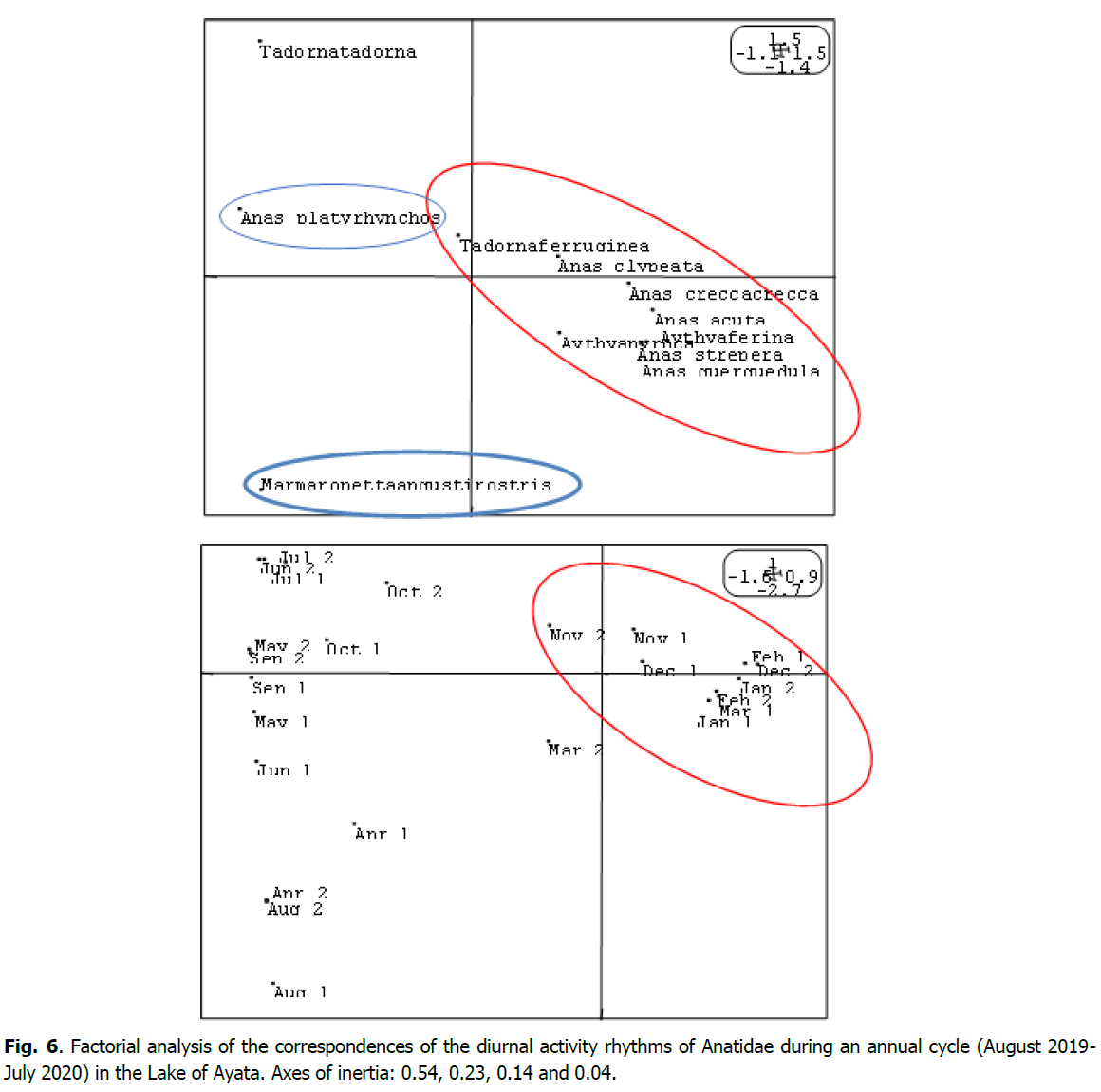
Fig 6. Factorial analysis of the correspondences of the diurnal activity rhythms of Anatidae during an annual cycle (August 2019- July 2020) in the Lake of Ayata. Axes of inertia: 0.54, 0.23, 0.14 and 0.04.
Discussion and Conclusion
The Anatidae family is the third largest group in terms of specific richness after the Rallidae and Podicipidae family (Heim De Balsac and Mayaud 1962; Isenmann and Moali, 2000). Lake Ayata is one of the most important wetland sites in the Oued Righ Valley which represent a set of oases circumscribed between the wilayas of Biskra, El-Oued and Ouargla, by the diversity of the aquatic avifauna, mainly that of Anatidae. This environment is, on the one hand, an ideal wintering site for many species of waterbirds (Anas acuta, Anas clypeata, Aythya nyroca, Anas crecca crecca, Tadorna tadorna (Sedik et al., 2010). On the other hand, it is a privileged reproduction site for other species such as, (Anas platyrhynchos, Marmaronetta angustirostris, Tadorna ferruginea). The presence of a good number of endangered species in this ecosystem such as: the Common Scaup (Aythya nyroca) which nest in very few wetlands nationwide (Boumezbeur 1993; Metallaoui and Houhamdi 2008, 2010; Aissaoui, 2009, Benradia et al., 2018) and the Marbled teal Marmaronetta angustirostris listed as endangered in the IUCN Red List category (VU) (Birdlife International, 2004), make it important areas to preserve. The majority of Algerian wetland complexes are frequented by 15 species of Anatidae (Chalabi and Belhadj, 1995; Mettallaoui and Houhamdi, 2010; Baaziz et al., 2011). During our study (2019/2020) we identified eleven species of birds with a maximum number of 537 winter individuals. The present results are similar to those found in eastern Algeria (Seddik et al., 2012; Boudraa et al., 2014; Elafri et al., 2017; Bouali et al., 2021) and in western Algeria ((Bouzegag et al., 2013; Bensaci et al., 2013; Nouidjem, et al., 2019). Daytime budgets are dominated by sleep activity and, therefore, the Lake of Ayata is an ideal refuge for reception of water birds (Houhamdi and Samraoui 2001, 2003, 2008; Metallaoui et al., 2014; Amorabda et al., 2015; Merzoug et al., 2014) and, like all Algerian wetlands, play the role of '' a stopover site for migratory species during their trans-Saharan migrations (Nouidjem, et al., 2019). This work underlines the general ecological importance of Lake Ayata in the south-east of Algeria and urgently promotes its protection and encourages local authorities to develop a conservation program to emphasize the ecological and ornithological value of this wet area.
References
Alizadeh, A.N. (1938). Materials to the hydrofauna of Nakhchivan АSSR. Proceeding Instittion of Zoology Az FAN of the USSR. 8:155-162.
Alizadeh, A.N. (1951). Freshwater mollusks. In Book: The Animal kingdom of Azerbaijan. Azerbaijan SSR Science Academic Press. Baku, pp:259-265.
Chernova, O.A. (1938). To the knowledge of mayflies (Ephemeroptera) of east Transcaucasia. Proceedings Institution of Zoology Az FAN of the USSR, 8:55-64.
Derjavin, A.N. (1938). Amphipoda of Nakhchivan АSSR. Proceedings Institution of Zoology Az FAN of the USSR, 8:163-184.
Farajev, G.R., Bayramov, A.B. (1988). Benthic organisms of Arpachay Reservoir. Proceedings Academic of Science Azerb SSR, Biological Science, pp:123-127.
Jadin, V.I. (1956). Methods of studying of the benthic fauna of water reservoirs and ecology of benthic invertebrates. In Book: Life of fresh waters. USSR Academic Science Press, 4:226-288.
Kirichenko, A.N. (1938). The true hemipteran insects (Hemiptera) of Nakhchivan АSSR. Proceeding Institute of Zoology Azerbaijan Branch of Academy of Sciences of the USSR, 8:75-122.
Mammadov, M.A. (2012). Hydrography of Azerbaijan. Baku, pp:126-130.
Martynov, A.V. (1938). Oncadedisflies of Nakhchivan АSSR and adjacent countries. Proceedings Institution of Zoology Az FAN of the USSR, 8:65-74.
Petrov, A.V. (1938). Essay about the hydrofauna of reservoirs of Nakhchivan АSSR. Proceedings Institution of Zoology Az FAN of the USSR, 8:185-213.
Rustamov, S.H. (1975). The hydrofauna of Nakhchyvan AR. 50th anniversary of the Nakhchivan Autonomous Soviet Socialist Republic, Baku, Elm, pp:297-313.
Sofiyev, Z.P. (1969). To the study of the benthic fauna of the rivers of Nakhchivan АSSR. Program and Material Scientific Conference of Graduating Students of Biological Faculty, Devoted 50th anniversary of AGU. Baku, pp:10-12.
Author Info
L. Soumaya1, A. Baaloudj2*, H. rizi3, I.E. Saker1, I. Houhamdi2, S. Sihem1 and M. Houhamdi22Laboratoire Biologie, Eau et Environnement (LBEE). Faculty SNV-STU. University 8 May 1945 Guelma. PB. 401 24000 Guelma, Algeria
3University Chadli Bendjedid d’El Tarf, 36000, Algeria
Citation: Laabed, S., Baaloudj, A., rizi, H., Saker, I.E., Houhamdi, I., Sihem, S., Houhamdi, M. (2021). Phenological status of Anatidae in the lake of Ayata- El-Oued (Algeria). Ukrainian Journal of Ecology. 11:43-47.
Received: 09-Dec-2021 Accepted: 13-Jan-2022 Published: 20-Jan-2022
Copyright: This is an open access article distributed under the terms of the Creative Commons Attribution License, which permits unrestricted use, distribution, and reproduction in any medium, provided the original work is properly cited.
